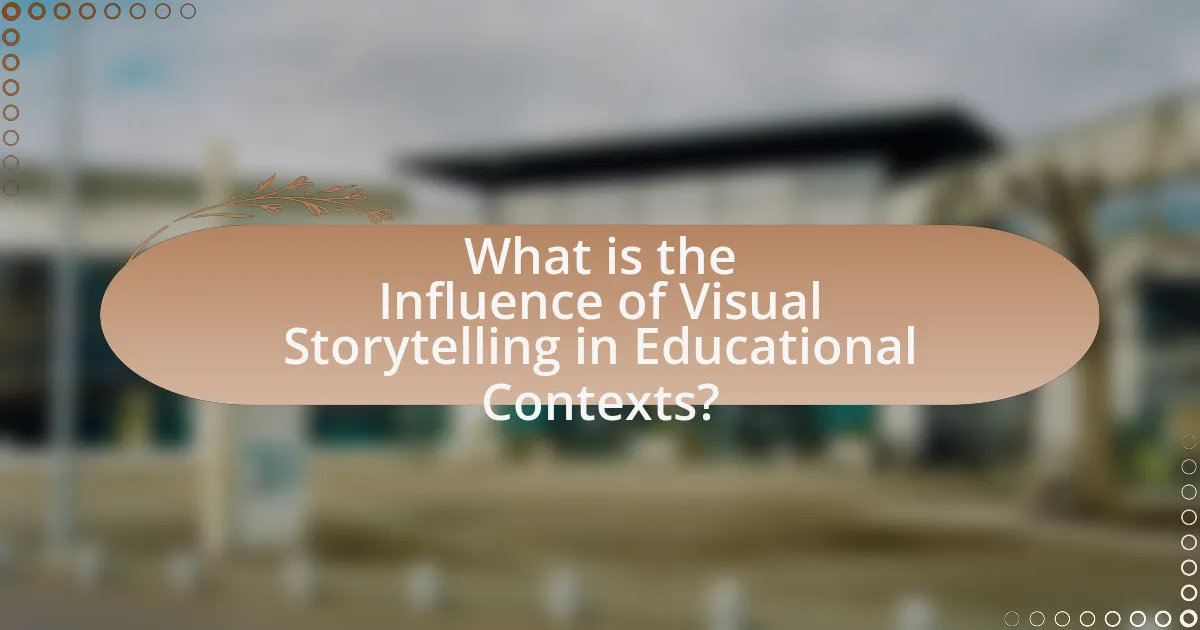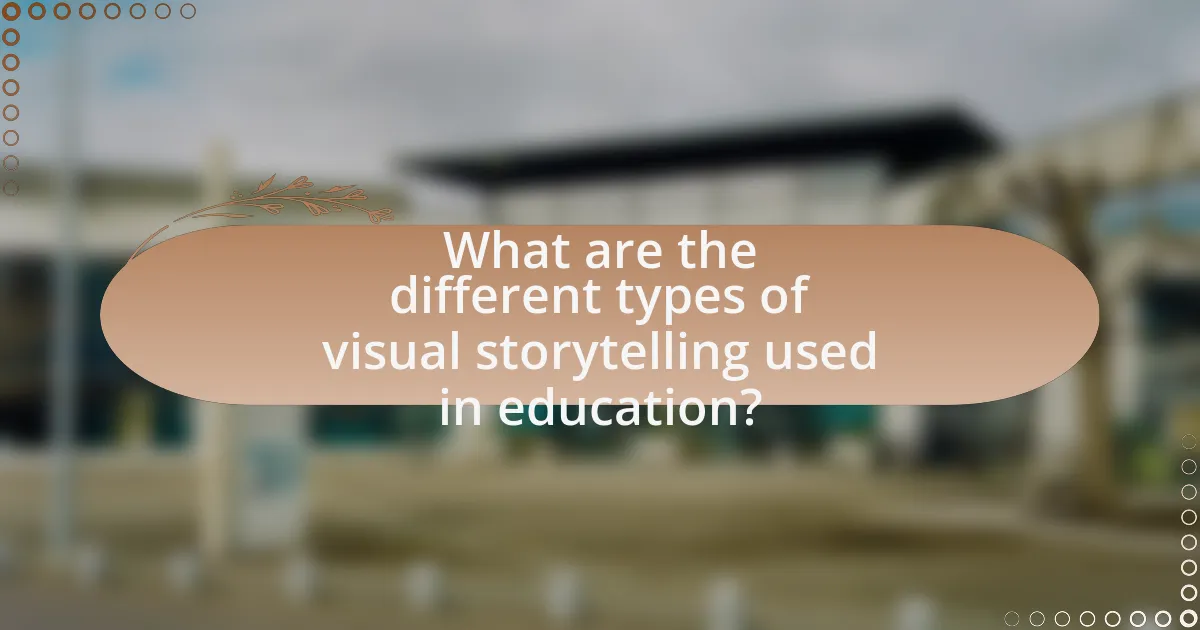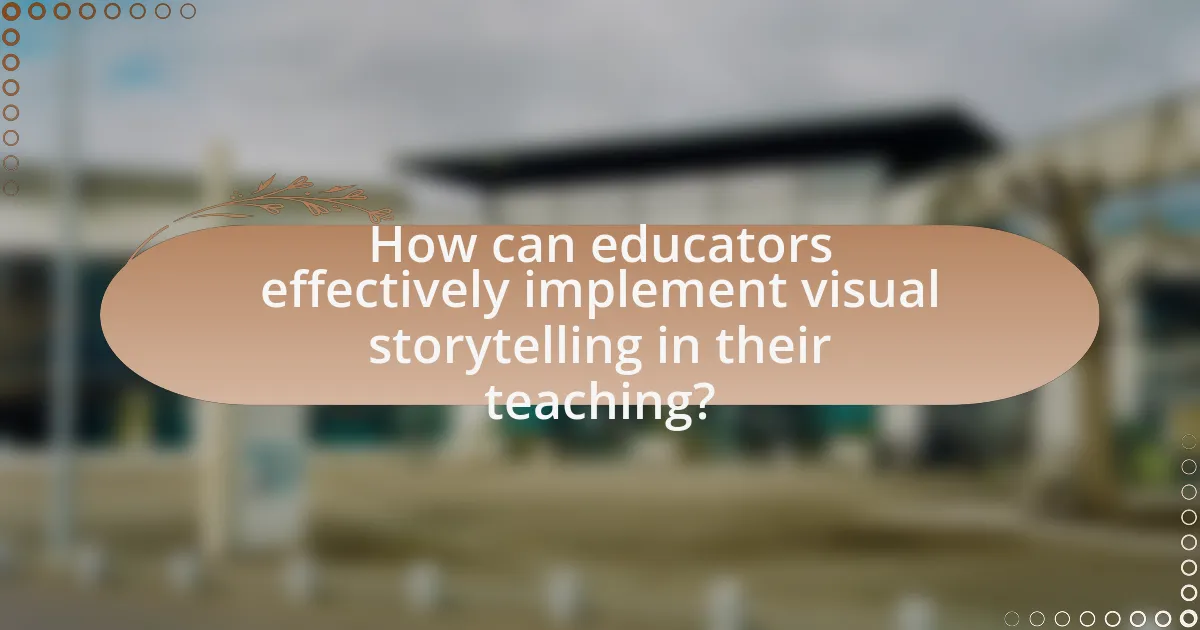Visual storytelling plays a crucial role in enhancing educational experiences by improving engagement, retention, and comprehension among learners. Research indicates that visuals can increase information retention by up to 65% when combined with verbal content, making complex concepts more accessible. Key elements of effective visual storytelling include clarity, emotional connection, and context, which cater to diverse learning styles. Various types of visual storytelling, such as infographics, videos, and interactive presentations, are explored, along with best practices for their implementation in educational settings. Additionally, the article addresses potential challenges and considerations for accessibility, ensuring that visual storytelling is inclusive and effective for all learners.

What is the Influence of Visual Storytelling in Educational Contexts?
Visual storytelling significantly enhances learning in educational contexts by improving engagement, retention, and comprehension. Research indicates that visuals can increase information retention by up to 65% when combined with verbal content, as demonstrated in studies by the University of California, which found that students who learned through visual means performed better on assessments compared to those who relied solely on text. Additionally, visual storytelling caters to diverse learning styles, making complex concepts more accessible and relatable, thereby fostering a deeper understanding of the material.
How does visual storytelling enhance learning experiences?
Visual storytelling enhances learning experiences by engaging learners through a combination of visual elements and narrative, which facilitates better retention and understanding of information. Research indicates that visuals can improve recall by up to 65% compared to text alone, as demonstrated in studies like those conducted by the University of California, which found that people remember 80% of what they see and do, versus only 20% of what they read. This dual coding of information—where both visual and verbal channels are utilized—creates a more immersive learning environment, making complex concepts easier to grasp and remember.
What are the key elements of effective visual storytelling in education?
The key elements of effective visual storytelling in education include clarity, engagement, emotional connection, and context. Clarity ensures that visuals are easily understood, allowing learners to grasp concepts quickly. Engagement captures students’ attention through dynamic visuals and narratives, fostering interest in the subject matter. Emotional connection enhances retention by relating content to students’ experiences or feelings, making learning more impactful. Context provides relevant background information that situates the visuals within the educational framework, aiding comprehension. Research indicates that visuals can improve information retention by up to 65%, highlighting their importance in educational storytelling.
How do visuals impact memory retention in learners?
Visuals significantly enhance memory retention in learners by facilitating better information processing and recall. Research indicates that the dual coding theory, proposed by Allan Paivio, suggests that information is more effectively remembered when it is presented both visually and verbally. A study published in the journal “Educational Psychology” by Mayer and Moreno (2003) found that learners who engaged with multimedia presentations that included visuals demonstrated higher retention rates compared to those who received only text-based information. This is attributed to the brain’s ability to create mental images, which aids in encoding and retrieving information more efficiently.
Why is visual storytelling important in modern education?
Visual storytelling is important in modern education because it enhances engagement and retention of information among learners. Research indicates that visuals can improve learning outcomes by up to 400%, as they help to simplify complex concepts and make them more relatable. Additionally, visual storytelling caters to diverse learning styles, allowing students to connect emotionally with the material, which further aids in memory retention. Studies show that incorporating visuals in educational content leads to better comprehension and recall, making it a vital tool in effective teaching strategies.
What challenges does traditional teaching face that visual storytelling addresses?
Traditional teaching faces challenges such as student disengagement, difficulty in retaining information, and a lack of personalized learning experiences, which visual storytelling effectively addresses. Visual storytelling engages students by presenting information in a narrative format that captures attention and enhances emotional connection, leading to improved retention rates. Research indicates that students remember 65% of information presented visually compared to only 10% when presented through text alone. Additionally, visual storytelling allows for differentiated instruction, catering to diverse learning styles and needs, thereby fostering a more inclusive educational environment.
How does visual storytelling cater to different learning styles?
Visual storytelling caters to different learning styles by engaging visual, auditory, and kinesthetic learners through a combination of images, narratives, and interactive elements. Visual learners benefit from graphics and illustrations that enhance comprehension and retention, while auditory learners gain from the accompanying narratives and sound effects that provide context and emotional engagement. Kinesthetic learners are engaged through interactive storytelling methods, such as role-playing or hands-on activities that allow them to physically interact with the content. Research indicates that incorporating multiple modalities in education, such as in the study by Fleming and Mills (1992), supports diverse learning preferences and improves overall learning outcomes.

What are the different types of visual storytelling used in education?
Different types of visual storytelling used in education include infographics, animations, videos, and interactive presentations. Infographics combine visuals and text to convey complex information succinctly, making them effective for summarizing data and concepts. Animations can illustrate processes or narratives dynamically, enhancing engagement and understanding. Videos provide a medium for storytelling that can incorporate real-life examples, interviews, and demonstrations, which can be particularly impactful in conveying emotional and contextual depth. Interactive presentations, such as those created with tools like Prezi or Google Slides, allow for audience participation and exploration of content, fostering a more immersive learning experience. Each type leverages visual elements to enhance comprehension and retention of educational material.
How do infographics contribute to visual storytelling in educational settings?
Infographics enhance visual storytelling in educational settings by simplifying complex information into easily digestible visual formats. They combine text, images, and data to create a narrative that engages learners and aids in comprehension. Research indicates that visuals can improve retention rates by up to 65%, as they cater to diverse learning styles and facilitate quicker understanding of concepts. By presenting information in a structured and visually appealing manner, infographics help students grasp and remember key ideas more effectively, thereby enriching the educational experience.
What are the best practices for creating educational infographics?
The best practices for creating educational infographics include clarity, simplicity, and effective use of visuals. Clarity ensures that the main message is easily understood, while simplicity helps avoid overwhelming the audience with excessive information. Effective visuals, such as charts and icons, enhance comprehension and retention of information. Research indicates that visuals can improve learning outcomes by up to 400%, as they facilitate quicker understanding and recall (Mayer, 2009, “Multimedia Learning”). Additionally, maintaining a consistent color scheme and typography aids in creating a cohesive design that supports the educational purpose.
How can infographics be integrated into lesson plans effectively?
Infographics can be integrated into lesson plans effectively by aligning them with learning objectives and using them as visual aids to enhance comprehension. Educators can incorporate infographics to summarize complex information, making it more accessible for students. For instance, a study by the University of Maryland found that visual aids can improve retention rates by up to 65%. By utilizing infographics in group discussions or as part of assessments, teachers can foster engagement and facilitate deeper understanding of the subject matter.
What role do videos play in visual storytelling for education?
Videos serve as a powerful tool in visual storytelling for education by enhancing engagement and facilitating comprehension. They combine auditory and visual elements, which cater to diverse learning styles and improve retention of information. Research indicates that learners retain 65% of information when it is presented visually, compared to only 10% when presented through text alone. This effectiveness is further supported by studies showing that multimedia learning can lead to a 50% increase in retention rates. Thus, videos not only capture attention but also significantly boost the educational impact of storytelling.
How can educators create engaging educational videos?
Educators can create engaging educational videos by incorporating storytelling techniques, interactive elements, and high-quality visuals. Storytelling captures attention and enhances retention; research shows that narratives can improve memory recall by up to 65%. Interactive elements, such as quizzes or prompts, encourage viewer participation, making the learning experience more immersive. High-quality visuals, including animations and graphics, can clarify complex concepts and maintain viewer interest, as studies indicate that visual aids can increase understanding by 400%. By combining these strategies, educators can significantly enhance the effectiveness and engagement of their educational videos.
What platforms are best for sharing educational videos?
YouTube and Vimeo are the best platforms for sharing educational videos. YouTube, with over 2 billion monthly users, offers extensive reach and a variety of educational channels, making it ideal for educators to share content. Vimeo, known for its high-quality video hosting, provides a professional environment with features like customizable players and privacy settings, which are beneficial for educational institutions. Both platforms support various formats and allow for audience engagement through comments and shares, enhancing the educational experience.

How can educators effectively implement visual storytelling in their teaching?
Educators can effectively implement visual storytelling in their teaching by integrating multimedia elements such as images, videos, and infographics into their lessons. This approach enhances student engagement and comprehension, as studies show that visual aids can improve retention rates by up to 65% compared to text-only materials. By using storytelling techniques, educators can create relatable narratives that connect with students’ experiences, making complex concepts more accessible. Additionally, incorporating tools like digital storytelling platforms allows students to create their own visual narratives, fostering creativity and critical thinking skills.
What strategies can teachers use to incorporate visual storytelling into their curriculum?
Teachers can incorporate visual storytelling into their curriculum by using multimedia presentations, graphic novels, and digital storytelling tools. Multimedia presentations, such as slideshows or videos, allow teachers to combine images, text, and audio to create engaging narratives that enhance understanding. Graphic novels can be integrated into literature lessons to provide visual context and stimulate discussions about themes and characters. Digital storytelling tools, like Storybird or Adobe Spark, enable students to create their own visual stories, fostering creativity and improving digital literacy. Research indicates that visual storytelling can improve retention and comprehension, as evidenced by a study published in the Journal of Educational Psychology, which found that students who engaged with visual narratives scored higher on comprehension tests compared to those who did not.
How can collaborative projects enhance visual storytelling in classrooms?
Collaborative projects enhance visual storytelling in classrooms by fostering teamwork and diverse perspectives, which enrich the narrative and visual elements of the stories created. When students work together, they combine their unique ideas and skills, leading to more innovative and engaging visual representations. Research indicates that collaborative learning environments improve critical thinking and creativity, as evidenced by a study published in the Journal of Educational Psychology, which found that students engaged in group projects demonstrated higher levels of creativity in their outputs compared to those working individually. This collaborative approach not only enhances the quality of visual storytelling but also promotes communication skills and social interaction among students, further contributing to a more dynamic learning experience.
What tools and resources are available for educators to create visual stories?
Educators can utilize various tools and resources to create visual stories, including platforms like Canva, Adobe Spark, and Storybird. Canva offers a user-friendly interface with templates for infographics and presentations, making it accessible for educators to design visually appealing content. Adobe Spark provides features for creating web pages, videos, and graphics, allowing for multimedia storytelling. Storybird focuses on combining art and text, enabling educators to create illustrated stories easily. These tools enhance engagement and facilitate creative expression in educational settings, supporting the effective use of visual storytelling.
What are the potential pitfalls of using visual storytelling in education?
The potential pitfalls of using visual storytelling in education include oversimplification of complex concepts, which can lead to misunderstandings among students. When educators rely heavily on visuals, they may inadvertently omit critical details necessary for comprehensive understanding. Additionally, visual storytelling can create cognitive overload if too much information is presented simultaneously, hindering retention and comprehension. Research indicates that students may also develop a preference for visual content over textual information, which can impair their reading and analytical skills. Furthermore, cultural differences in interpreting visuals can lead to miscommunication and misinterpretation of the intended message, affecting learning outcomes.
How can educators avoid common mistakes when using visuals?
Educators can avoid common mistakes when using visuals by ensuring that visuals are relevant, clear, and appropriately integrated into the lesson. Relevant visuals enhance understanding by directly supporting the content being taught, while clarity ensures that students can easily interpret the information presented. Additionally, integrating visuals seamlessly into the lesson plan prevents distractions and maintains focus on the learning objectives. Research indicates that effective visual aids can improve retention and comprehension, as evidenced by studies showing that students retain 65% of information when paired with relevant visuals compared to 10% without them.
What considerations should be made regarding accessibility in visual storytelling?
Accessibility in visual storytelling requires the incorporation of elements that ensure all audiences, including those with disabilities, can engage with the content. Key considerations include the use of alternative text for images, ensuring color contrast for readability, providing captions and transcripts for audio and video materials, and designing layouts that accommodate screen readers. Research indicates that approximately 15% of the global population experiences some form of disability, highlighting the necessity for inclusive design practices in educational contexts. By implementing these strategies, visual storytelling can effectively reach and resonate with a diverse audience, enhancing learning outcomes for all.
What are some best practices for using visual storytelling in educational contexts?
Best practices for using visual storytelling in educational contexts include integrating visuals that enhance comprehension, utilizing narrative structures to engage learners, and ensuring accessibility for diverse audiences. Research indicates that visuals can improve retention rates by up to 65% when paired with relevant narratives, as demonstrated in studies by Mayer and Moreno (2003) on multimedia learning. Additionally, employing a clear storyline helps maintain student interest and facilitates deeper understanding of complex concepts. Lastly, incorporating diverse visual formats, such as infographics and videos, caters to various learning styles, making education more inclusive and effective.
How can feedback be effectively gathered on visual storytelling methods?
Feedback on visual storytelling methods can be effectively gathered through structured surveys, focus groups, and direct observation. Structured surveys allow participants to rate various aspects of the visual storytelling, such as clarity, engagement, and emotional impact, providing quantifiable data for analysis. Focus groups facilitate in-depth discussions, enabling participants to express their thoughts and feelings about the storytelling methods, which can reveal insights not captured in surveys. Direct observation during presentations or workshops allows educators to assess audience reactions and engagement levels in real-time, offering immediate feedback on the effectiveness of the visual storytelling. These methods collectively enhance the understanding of how visual storytelling influences learning outcomes in educational contexts.
What ongoing training can educators pursue to improve their visual storytelling skills?
Educators can pursue ongoing training in visual storytelling through workshops, online courses, and professional development programs focused on multimedia design and narrative techniques. For instance, platforms like Coursera and edX offer courses specifically on visual communication and storytelling, which enhance skills in creating engaging visual content. Additionally, organizations such as the International Society for Technology in Education (ISTE) provide resources and training sessions that emphasize the integration of visual storytelling in educational practices. These training opportunities are supported by research indicating that effective visual storytelling can significantly enhance student engagement and comprehension, as highlighted in studies published in the Journal of Educational Psychology.